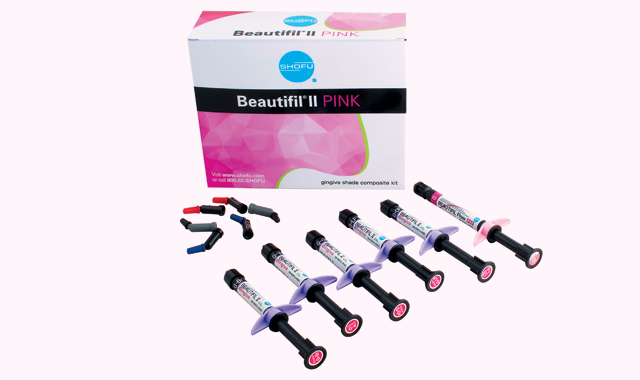A review of Beautifil II Gingiva composite
How one practitioner uses Shofu's gingiva-shaded composite in his practice.

Shofu Beautifil II Gingiva Direct resin composites were developed for the cervical area, specifically for esthetic correction of gingival recession, wedge-shaped defects, exposed cervical areas, splinting and re-balancing of pink esthetics. The pink-colored Beautifil II Gingiva was created based on Shofu’s Ceramage line, a nano-ceramic indirect composite designed for artistic restorations of anterior regions.
We talked to Dr. Hugh Flax, DDS, AAACD, MICOI, a cosmetic dentist in Atlanta and former president of the American Academy of Cosmetic Dentistry, about gingiva-shaded composites, when they should be used and tips for best practices.
Related reading: Shofu launches Beautifil II Gingiva and Enamel resin composite
Besides their color, how do these composites vary from others?
They have a nice variety of colors. They tend not to turn orange, which happens with a lot of these after exposure to the moisture in the mouth. I also find that these new composites have a nice polishability, no porosity and allow me to create restorations with a natural glaze.
What are these composites used for? Are there specific indications for their use?
Most of the time clinicians are going to use them when they’re trying to create an ideal esthetic result and there’s a gap between the white and the pink. In other words, there’s not enough bone to support the pink, so there’s a functional and esthetic defect that you’re trying to correct.
In other words, the old adage: “The tissue is the issue, but the bone sets the tone.”
When selecting a composite, what sorts of things should the clinician look for? Are there certain traits that you advise when choosing a gingiva-shaded composite?
Really there are two of them. Because we are dealing with circulation, you want to try to pick a shade when the tissue has not been numbed or disturbed, so I usually do that first. And then the second thing is you have to look at where the defect is, and you have to kind of regionalize it, just like you’re doing a tooth. Is it somewhere close to the root or below the root? It really is a factor of the amount of bone. If we’re trying to use a pink composite that mimics the attached gingiva, you’re going to want to have something that has a little bit of a pinker tissue, where if something is lower than the mucogingival junction, then you’ll probably want to have something that will mimic unattached gingiva, and that would have kind of a redder appearance to it. That’s just a rule of thumb.
Related reading: Shofu to feature three innovative products at Chicago Midwinter Meeting
What are some of the common mistakes that clinicians make when working with gingiva-colored composites?
My biggest mistake is not doing a mockup. I like to do a mockup first and then walk away-let my eyes rest, let the tissue rest. And then usually my staff has placed a topical, or something like that. So the patient’s getting numb and I usually let my staff do that, because they have a fairly good eye for this now. Then I come back and take a look at it and say, “Okay, is this the right shade here?” And then we work from there.
The other clinical mistake is not blending the pink into the gum tissue, so you need to use a composite brush, just to lightly blend that in there, so you get a nice, undetectable seam in there, so that there’s no gap for food to catch or create an esthetic liability.
Is there anything else you’d like to mention about gingiva-shaded composites?
This is an untapped area in dentistry, because we have a population that is getting older and they’re running out of tooth and they’re running out of bone. If they’re doing implant dentistry or if they’re doing fixed restoratives, we’ve got to have things that meet their esthetic demands because you want people to look and feel their best.
ACTIVA BioACTIVE Bulk Flow Marks Pulpdent’s First Major Product Release in 4 Years
December 12th 2024Next-generation bulk-fill dental restorative raises the standard of care for bulk-fill procedures by providing natural remineralization support, while also overcoming current bulk-fill limitations.